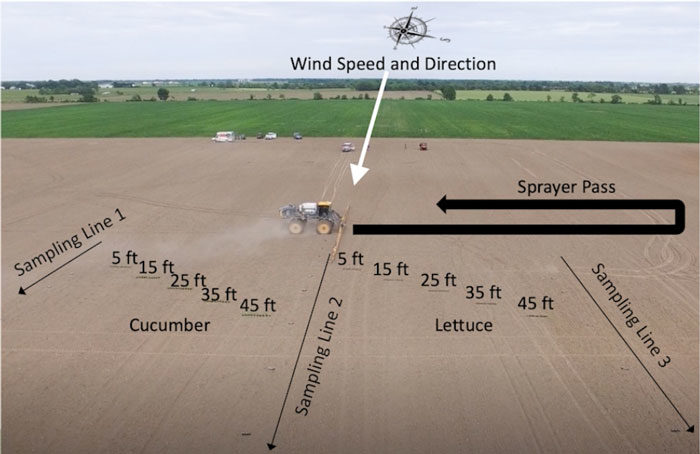No-Till Farmer
Get full access NOW to the most comprehensive, powerful and easy-to-use online resource for no-tillage practices. Just one good idea will pay for your subscription hundreds of times over.

AERIAL DESIGN. Pictured is a field drift research design featuring two parallel swaths applied upwind of a sampling array containing sensitive non-target plants placed at predefined downwind distances. The purpose is to assess potential effects of spray drift. Stainless-steel sampling devices also measure drift deposition and interception. Image: Richard Brain/Dan Perkins
EPA regulations require farmers to follow pesticide labels for the products they apply on their land. Protecting endangered plant and animal species plays a significant role in the decision-making process for these regulations. However, a new study shows that these protections might be overly broad and unreasonably conservative.
Currently, the EPA’s risk paradigm suggests that, for most effective herbicides, a spray drift buffer/setback distance of 300-1,000 feet is necessary to mitigate against potential impacts to endangered plant and/or animal species.
Richard Brain, an environmental toxicologist with Syngenta, and Dan Perkins, a sole proprietor with Ag Insight, conducted several field drift experiments to demonstrate the paradoxical nature of the EPA’s risk assessment, resulting in buffer/setback predictions that significantly overestimate necessary protections. Their solution, they believe, would be mutually beneficial for farmers and regulators, and would result in an “everybody wins” scenario.
“If you’re going to adopt upfront mitigations and you want them to be pragmatic and you want growers to actually use them, they have to be realistic,” Brain says. “That’s the message we’re trying to convey to the agency — don’t come up with mitigations that are hypothetical and predicated on highly conservative model predictions. Make the mitigations meaningful and based on the data that have already been generated.”
Brain and Perkins used a modified version of the same study design that the EPA uses and standardized to assess drift. The duo chose cucumber and lettuce plants for their experiment because they are the crops most sensitive to the herbicide…